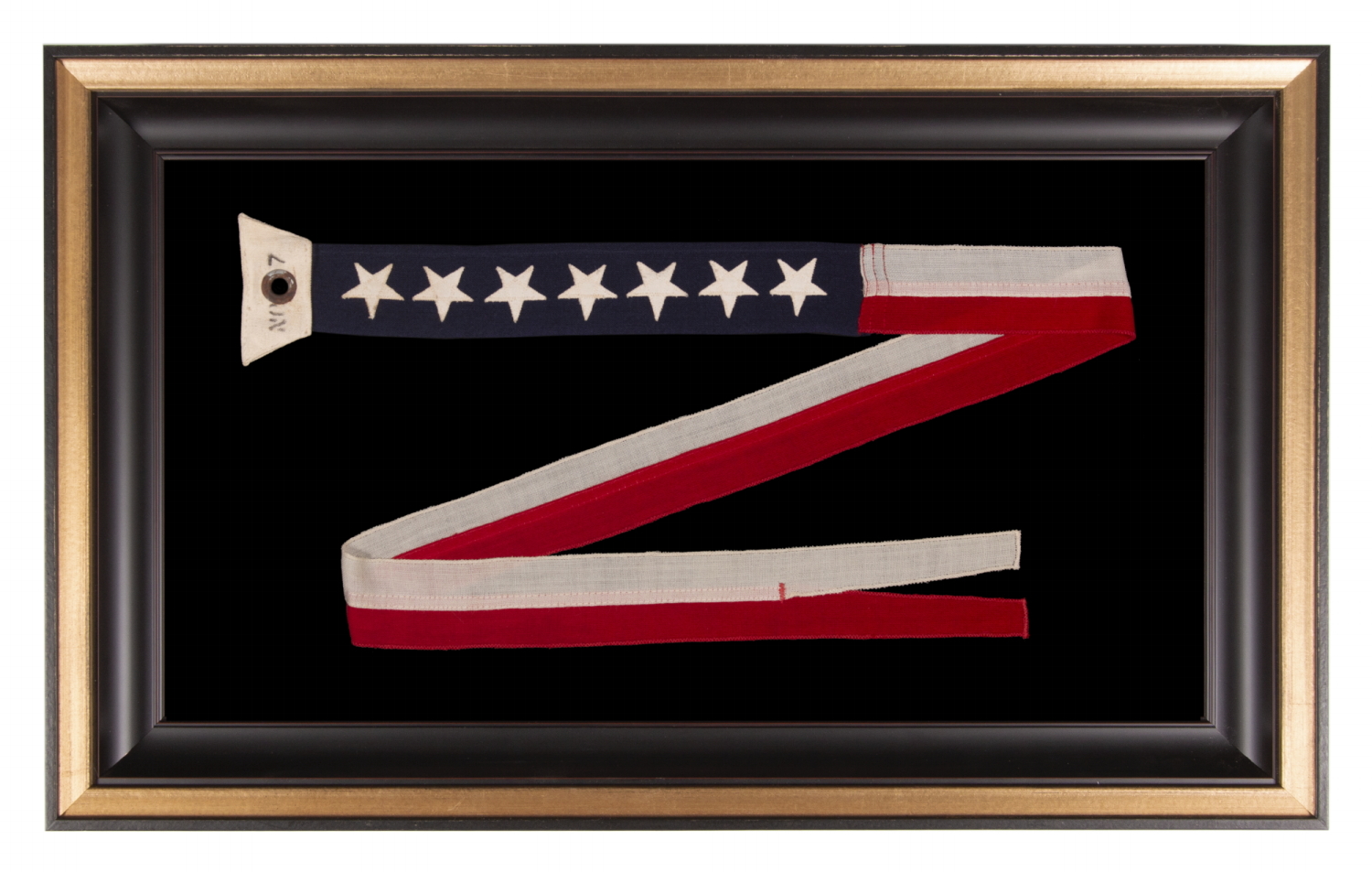
| |
U.S. NAVY COMMISSION PENNANT WITH 7 STARS, A 5 FT. EXAMPLE, circa WWII ERA |
|
| Available: |
Sold |
| Frame Size (H x L): |
19.5" x 32" |
| Flag Size (H x L): |
4" @ binding, 2.25" @ body of flag x 60.75" on the fly |
|
| Description....: |
|
7 star, nautical, ship's commission pennant, made sometime during WWII (U.S. involvement 1941-1945) or just following. Commission pennants are the distinguishing mark of a U.S. Navy ship. A ship became commissioned when this pennant was hoisted. Flown during both times of peace and war, the only time the pennant is not flown is if a flag officer or civilian official is aboard and replaces it with their own flag.
Commissioning pennants were once very important in their role as signals and thus needed to be seen from great distance. During the 18th and 19th centuries, they usually exceed ten feet in length, with some reaching as long as a hundred feet. Sometime around 1910, the function of commission pennants leaned away from identification and more toward ceremony and custom. By WWI (U.S. involvement 1917-18), most were one of just two sizes and tiny compared to their predecessors, measuring just four or six feet on the fly. Today the largest measure two-and-a-half inches by six feet. This is a 5-foot example, which is somewhat unusual.
Early on, commission pennants had a number of stars equal to that on the national flag. As more and more states joined the Union, however, it became impractical to use the full complement of stars, especially on smaller examples. During the mid-late 19th century, many substituted 13 stars for the full count, to reflect the original colonies. This mirrored the star count used by the Navy on most of the Stars & Stripes flags that it flew on small craft. "U.S. Navy small boat ensigns," as they are called, most often had 13 stars.
In the latter half of the 19th century, the smallest examples sometimes displayed just 7 stars. By WWI, all shared the 7 star count. It is of interest to note that, according to the U.S. Navy, the reason for the choice of 7 stars was not recorded. I once suspected this the number might logically reference the "7 Seas", before I discovered that this is a mythicized, ancient term, and geographers disagree on the precise meaning. The number may just as likely have represented what seemed like a logical design choice, when the overall length was substantially shortened. For some reason, many 20th century examples display two sizes of stars, with 4 larger, followed by 3 smaller. This may also have been a matter of practicality, because the length of the blue canton was so much larger on a tapering, 4 or 6 foot pennant, versus, say, a 20 or 40-foot example. But the height of the canton typically didn’t change over its length, and decreasing star size was not common in the 19th century and prior. So the reason for having two sizes of stars is, like their count of 7, also unknown.
This body of this particular pennant is made of wool bunting. The cotton stars are appliquéd with a zigzag, machine stitch. There is a sailcloth canvas binding along the hoist, with a tapered, trapezoidal profile, along which “No 7” was stenciled in black, which corresponds its numeric designation in U.S. Navy regulations. There is a single, white metal grommet.
Mounting: The pennant was folded back-and-forth in an interesting zigzag fashion. It was mounted and framed within our own conservation department, which is led by expert staff. We take great care in the mounting and presentation of flags and have preserved thousands of examples.
The background fabric is 100% cotton twill, black in color. The cove shaped molding has a very dark brown finish, almost black, with red undertones and highlights. To this a black-painted, hand-gilded and distressed Italian molding was added as a cap. Spacers keep the textile away from the glazing, which is U.V. protective glass. Feel free to contact us for more details.
Condition: Excellent, with extremely minor soiling. |
|
|
|
| Collector Level: |
Beginners and Holiday Gift Giving |
|
| Flag Type: |
Sewn flag |
|
| Star Count: |
07 |
|
| Earliest Date of Origin: |
1941 |
|
| Latest Date of Origin: |
1950's |
|
| State/Affiliation: |
|
|
| War Association: |
WW 2 |
|
| Price: |
SOLD |
|
| |
Views: 456 |
|
|
|

